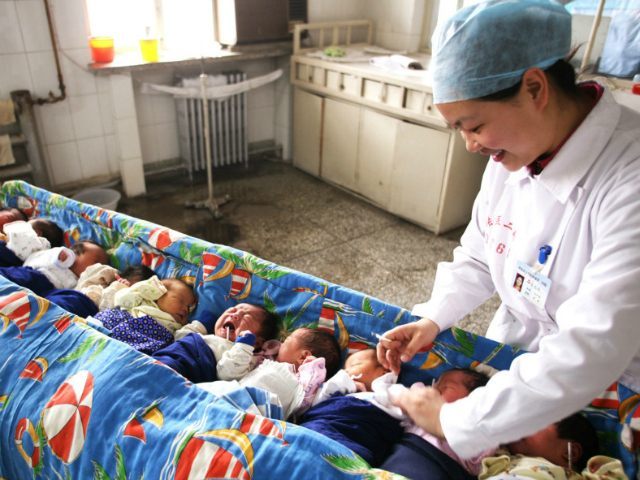China’s National Bureau of Statistics published the results of its 2020 national census Tuesday, revealing one of the most modest population increases in the country’s history and prompting panic in Chinese government media that the nation would soon have the world’s lowest fertility rate.
China’s Global Times, citing government-approved demographers, concluded that “the general declining trend was inevitable, and China’s population is likely to start to decline as early as 2022.” In April, following a delay in the publication of the full population report by the Communist Party, Western news outlets predicted the population had already begun to fall in 2020. Beijing denied this, claiming instead small population growth, though extensive evidence surfaced throughout 2020 that China may have been obscuring the true, and extremely high, number of deaths attributable to Chinese coronavirus since the pathogen first began infecting people in central Wuhan, Hubei province, in late 2019.
Chinese state media had already referred to China’s birth rate as “alarming” prior to the publication of 2020 statistics. While the government publishes its birth rate annually, the census fully detailing the number of people and social category breakdown of the country is published once a decade. Tuesday’s is the nation’s seventh census under communism.
The more optimistic numbers nonetheless prompted significant concern in the pages of state-run publications like the Global Times and Xinhua, which urged the Communist Party to rescind policies limiting how many children couples can have. For decades, the Communist Party imposed a strict “one-child policy” on the nation’s families, killing children born “illegally” either in the womb or shortly after birth. Dictator Xi Jinping extended the policy to two children in 2016, but over a generation of birth limits appear to have dampened enthusiasm for becoming parents and the birth rate continued to decline for the next five years.
The National Bureau of Statistics revealed Tuesday that the official population of China is 1.412 billion people, an increase of about 12 million from 2019. As the “one-child” and “two-child” policies have led to the mass killing of baby girls — families prefer sons and will “wait” for one to keep legally — China now has 34.9 million more men than women. Societies in which governments do not micromanage childbirth typically have a larger pool of women than men, which helps preserve the population.
While the population increased, the statistics showed a decline in the number of newborns between 2019 and 2020. The government documented 12 million births in 2020 compared to 14.65 million in 2019. In 2016, the year the “two-child policy” became law, Chinese families welcomed 17.86 million babies. China’s current fertility rate stands at 1.3 children per mother; experts consider 2.1 children per mother the “replacement” level necessary to keep a population stable.
“If no forceful intervention policy is introduced, China’s fertility rate may become the lowest in the world,” the Global Times warned Tuesday, citing “demographers.”
“According to the existing data, in the next 10 years, the number of women aged 22 to 35, which is the childbearing period, will drop by more than 30 percent compared with the present data,” one of the experts in the report, Liang Jianzhang, said. “Without strong policy intervention, China’s newborn population is likely to fall below 10 million in the next few years, and its fertility rate will be lower than Japan’s, perhaps the lowest in the world.”
The Global Times predicted, again citing government-approved “experts,” that “there is no doubt that China will fully lift family planning policy in the near future to cope with the declining birth rate and China is likely to remove its family planning policy as early as this autumn.” The experts appeared to be referring to the two-child policy imposed on the nation’s Han ethnic minority, not the systematic sterilization of women of child-bearing age belonging to the ethnic Uyghur minority.
The newspaper also urged the government not simply to remove limits to expanding families, but to “subsidize” childbirth to encourage couples to conceive. Other government policies seemingly tied to efforts to increase the population include calls from Chinese lawmakers for more detailed sex education in schools and an increasingly hostile campaign to censor feminist opinions online, particularly those from women who reject being cornered into motherhood as a societal duty.
The Times also expressed concern about the nation’s shrinking labor force as older Chinese citizens retire and couples fail to have children.
“Chinese demographers said that the seventh population census results were released as China’s population development entered a critical turning point,” the newspaper warned, “with a rapidly aging population and a five-decade trend of population growth was about to end.”
China lost 40 million workers in its labor force between 2010 and 2020, according to the census. The Global Times nonetheless proclaimed that China maintained significant advantages in its market, “labor resources are still abundant,” and its aging population was still “energetic.”
The state news agency Xinhua urged a “rational” approach to the disastrous census results on Tuesday, reiterating the false claim that China had “eradicated absolute poverty with arduous efforts” and asserting that the totalitarian regime had the power and will to reverse the population collapse.
“China’s population growth is also of great significance to the world,” Xinhua contended. “With 400 million middle-income earners, China will further unlock its market potential and create greater demand for other countries. It will take a more active role in the international division of labor and share more opportunities for common development.”

COMMENTS
Please let us know if you're having issues with commenting.